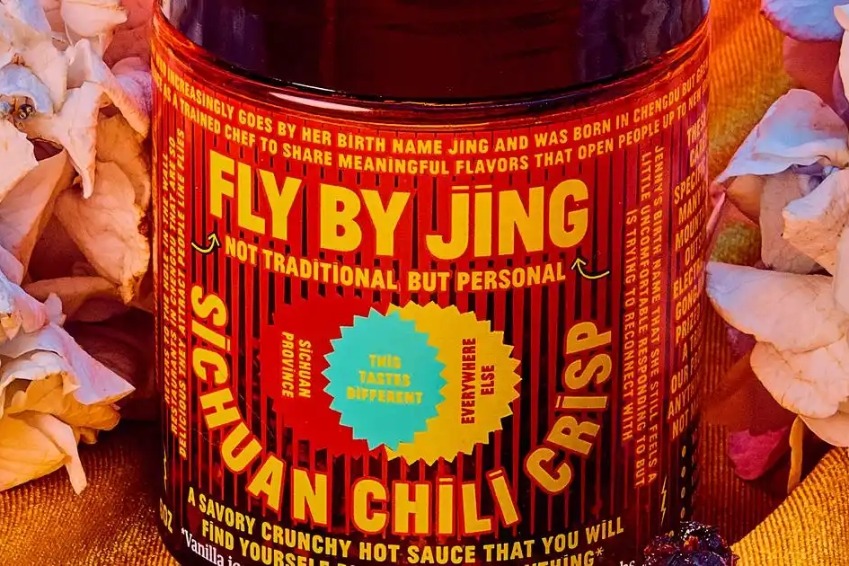US market spicing up sales for Sichuan flavor chili sauce

In a culinary landscape dominated for decades by Western flavors and familiar sauces in the US market, Fly By Jing has carved out a space not only as a breakout condiment brand, but also as a cultural ambassador for modern Chinese cuisine.
What started as a personal journey to reconnect with heritage has grown into one of the fastest-growing Asian food brands in the United States — redefining what Chinese flavors can mean to US consumers.
Before launching Fly By Jing in 2018, founder Gao Jing worked in the tech sector for a US firm in China. But it was in food — particularly the fiery, aromatic cuisine of her hometown of Chengdu, Sichuan province — where she found her true calling.
Gao left her job, dove deep into the world of Sichuan cooking, and opened a restaurant in Shanghai. While that early restaurant venture no longer exists, it laid the groundwork for a much more scalable mission — bringing real Sichuan flavors to the global stage.
"I started studying Chinese cooking as a way to reconnect with my identity," Gao said during the recent FBIF 2025 Food and Beverage Innovation Forum in Shanghai.
"Through cooking and hosting events around the world, I saw a growing interest in Sichuan flavors. But people lack understanding and access to these ingredients in the West."
Gao zeroed in on a versatile staple from her kitchen — chili sauce. Unlike typical hot sauces in the US market, her version came loaded with texture, complexity and authentic Chinese ingredients, including fermented black beans, fragrant Sichuan peppercorns, aged chili oil and no artificial additives. Rather than dilute the flavor for Western palates, Gao doubled down on authenticity.
"I didn't adapt the sauce to American tastes," she said. "Instead, I adapted the story around it. We showed people how our chili sauce could pair with familiar foods like pizza, burgers and salads. That broke down the barrier."
Fly By Jing's rise was grassroots and strategic. The brand launched via Kickstarter, a crowd-funding platform where people pay in advance for products still in development, tapping into an audience of adventurous early adopters — foodies, creators and influencers on the lookout for the next big thing. Social media, especially Instagram, became an engine for word-of-mouth marketing.
"Our target audience was people like me — diverse-minded, flavor-loving professionals in cities like New York and LA," Gao said. "Kickstarter helped us find trend-setters who shared our story with their communities."
The campaign was a success, and soon Fly By Jing transitioned from a labor of love project to a full-fledged consumer packaged goods company.
The company now sells some 10 products online and through over 12,000 retail locations and platforms in the US including Whole Foods, Target, Walmart, Costco and Amazon. Each product is priced between $10 and $15.
The brand has become synonymous with the "chili crisp" trend, outpacing condiments like ketchup and mayonnaise in growth. In 2024, Fly By Jing became the No 1 chili crisp brand in the US — a milestone that speaks both to consumer demand and strategic execution.
The company remains committed to quality and tradition. All ingredients are sourced and manufactured in Chengdu. This wasn't always easy, as early on, it took six months just to convince a local factory to work with them.
Most manufacturers wanted to cut corners, use cheaper substitutes, said Gao. But after training under a master chef in Chengdu, she knew how much the ingredients mattered. Cutting costs would've meant losing the flavor that made their sauces special, she said.
The company's chili sauce contains 18 all-natural ingredients and no preservatives or MSG. The sauce comes from layering real aromatics — ginger, garlic, shallots, black beans — not shortcuts.
As a brand that manufactures entirely in China, Fly By Jing has also had to navigate the shifting tension as a result of the US-China trade policy. The company's first shipment to the US arrived shortly after tariffs were raised, significantly increasing costs. "Big retailers like Walmart can absorb those costs for their own brands," Gao said. "But for an independent startup, we don't get that support. It's been tough over the short-term."
Despite the headwinds, Gao remains optimistic. "We're taking a wait-and-see approach."
For her business, Gao believes the journey is only just beginning. "The category is still wide open. We're just scratching the surface."
To keep growing, Fly By Jing is expanding both its product line and its distribution strategy. The brand currently offers four core retail products and recently introduced a line of noodles paired with sauce.
It's a logical extension. Noodles are widely recognized in the US and the format allows new customers to try Fly By Jing's signature flavors in a convenient, ready-to-cook form.
At the same time, the team is developing more accessible formats for its sauces. The original chili crisp comes in a glass jar — a premium presentation, but not always convenient. US consumers often prefer squeeze bottles, like ketchup. That's challenging with oil-based sauces because the solids settle, but Gao and her team are exploring alternatives such as stir-fry sauces and compound sauces that retain the brand's Asian flavor identity while offering ease of use.
While Fly By Jing has roots in China, its business remains focused on the US market for now.
"We're a small team with limited resources," Gao said. "The US is still our biggest opportunity. We've just expanded into over 5,000 Walmart stores, and now we're reaching consumers in the interior of the country who've not often tasted chili crisp."
That expansion brings its own challenges, especially when it comes to education. Many consumers still don't know how to use the product, or associate Chinese food only with takeout. To bridge that gap, the company invests in storytelling — via packaging, social media and retail partnerships — to demonstrate versatility and familiarity.
"There was nothing like this on the market when we launched," Gao said. "And now, we're showing people that Chinese flavors can be high-quality, modern and universal. It's just the beginning."




































